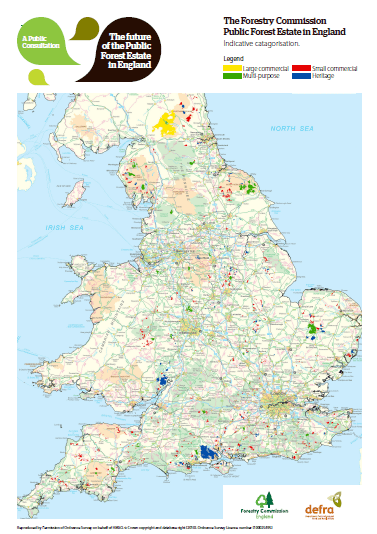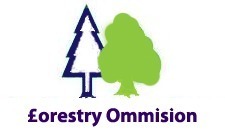 Local action against the public sale of forests has galvanised strongly when centred on England’s large heritage forests (read more). The power of these campaigns, due to their large number of supporters and backing of celebrities, in my view makes any radicle change of ownership highly unlikely. I believe the actual frontline will be the myriad of small woodlands dotted across England that will be precious only to local people.
Local action against the public sale of forests has galvanised strongly when centred on England’s large heritage forests (read more). The power of these campaigns, due to their large number of supporters and backing of celebrities, in my view makes any radicle change of ownership highly unlikely. I believe the actual frontline will be the myriad of small woodlands dotted across England that will be precious only to local people.
I was recently asked by one reader about their local wood. How could he find out more: was the woodland threatened by sale, and could he join a local action group?
The question of which woodlands may be sold can be found out by looking at Defra’s rather poor map that is offered as one of the downloads in the consultation document. You can access it directly by clicking on the map image.
![]() The frontline, as I see it, are the woodlands in denoted in red. The only large commercial forest area (yellow) is Kielder Forest in Northumberland: I was surprised that areas of Thetford and the North York Moors escaped this categorisation. The heritage forests (blue) and multi-purpose forests (green) are both pretty safe in my view, as their high public benefit value, especially public access, will ensure that their disposal will be handled very carefully by Government. It is the red-highlighted small commercial woodlands that are the ones to watch.
The frontline, as I see it, are the woodlands in denoted in red. The only large commercial forest area (yellow) is Kielder Forest in Northumberland: I was surprised that areas of Thetford and the North York Moors escaped this categorisation. The heritage forests (blue) and multi-purpose forests (green) are both pretty safe in my view, as their high public benefit value, especially public access, will ensure that their disposal will be handled very carefully by Government. It is the red-highlighted small commercial woodlands that are the ones to watch.
You will need to zoom into the document to try to work out which woodland you are interested in. Unfortunately no background information is supplied by Defra that would be helpful to the public in supporting their response to these proposals in any detail. We should have been provided with a spreadsheet containing all the woodlands: their names, areas, grid reference, simple timber and land £ valuation, visitor numbers, public and permitted access rights, species content, any designation (e.g. SSSI, AONB etc.). Even more helpful and transparent would have been their disposal score (based on how they were rated based on provision of public benefits, nearness to urban centres, timber value etc.).
In answer to the question about finding a local action group, there do appear to be more campaign groups coming together to defend the smaller woodlands. It takes a passionate group of local people to make this happen, with the skills and time to inform local people, organise events, create press interest and to develop an online presence. In other words Big Society in action but perhaps not as the Government anticipated!

Gabriel Hemery
 This work is licensed under a Creative Commons Attribution- NonCommercial- NoDerivs 3.0 United States License.
This work is licensed under a Creative Commons Attribution- NonCommercial- NoDerivs 3.0 United States License.

I think that the public forest estate should retain the small and large commercial woodlands. Kielder is an opportunity for landscape scale conservation and it could be reshaped over time. We desperately need larger landscapes if we are to create sustainable communities of fauna and flora. There cannot be too many Kielders! The smaller commercial woods should continue in public ownership or perhaps be taken in under endowment or a management scheme by a body such as the Land Trust. If they stayed with the FC then the FC could ork with community groups. I chair a conservation group in Basingstoke on 24 acres of publicly owned land and it is difficult – even with a large population on the doorstep! A colleague of mine chairs another group with about half that land area that is all coppice and they struggle as well. There is a need for these smaller woods/forests to be under some kind of core management responsible for H&S, core admin and planning and with access to machines etc. Volunteers, many of wom are happy doing the physical or even doing recording and similar tasks can then do the things they want. I simply see no need to dispose of commercial woodland. The private estate is 80% already and if anything I would rather see the PFE expanded in a strategic way to restore biodiversity and reverse the dreadful excesses of past generations, including our own. I have no problem with commercial woodland within that but am not sure that plantations are the right solution even if they are the most efficient.
Good post – however the same process of a “passionate group of local people” could also take advantage of the proposals to actually take over the management of the woodland into their own hands? Provided with appropriate (and varied) professional advice it would be strange if in some cases local people might have views on species choice, continuous cover vs clearfelling, types of access provision, and other issues, which differed from FC policies and assumptions. Local groups can state a wish to buy the woods under the proposals. Though this is of course one of the consultation issues.